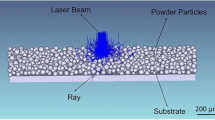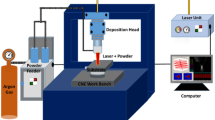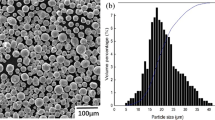Abstract
Titanium-based alloy products manufactured by Selective Laser Melting (SLM) have been widely used in biomedical applications, owing to their high biocompatibility, significantly good mechanical properties. In order to improve the Ti–6Al–4V SLM-fabricated part quality and help the manufacturing engineers choose optimal process parameters, an optimization methodology based on an artificial neural network was developed to relate four key process parameters (laser power, laser scanning speed, layer thickness, and hatch distance) and two target properties of a part fabricated by the SLM technique (density ratio and surface roughness). A supervised learning deep neural network based on the backpropagation algorithm was applied to optimize input parameters for a given set of quality part outputs. Several methods were utilized to solve undesired problems occurring during neural network training to increase the model accuracy. The model’s performance was proven with a value of R2 of 99% for both density ratio and surface roughness. A selection system was then built, allowing users to choose the optimal process parameters for fabricated products whose properties meet a specific user requirement. Experiments performed with the optimal process parameters recommended by the optimization system strongly confirmed its reliability by providing the ultimate part qualities nearly identical to those defined by the user with only about 0.9–4.4% of errors at the maximum. Finally, a graphical user interface was developed to facilitate the choice of the optimum process parameters for the desired density ratio and surface roughness.








Similar content being viewed by others
References
Abadi, M., Barham, P., Chen, J., Chen, Z., Davis, A., Dean, J., et al. (2016). TensorFlow: A system for large-scale machine learning (pp. 265–283). Presented at the 12th USENIX Symposium on Operating Systems Design and Implementation. https://www.usenix.org/conference/osdi16/technical-sessions/presentation/abadi
Acharya, R., Sharon, J. A., & Staroselsky, A. (2017). Prediction of microstructure in laser powder bed fusion process. Acta Materialia, 124, 360–371. https://doi.org/10.1016/j.actamat.2016.11.018
Ali, H., Ghadbeigi, H., & Mumtaz, K. (2018). Effect of scanning strategies on residual stress and mechanical properties of Selective Laser Melted Ti6Al4V. Materials Science and Engineering: A, 712, 175–187. https://doi.org/10.1016/j.msea.2017.11.103
Alrbaey, K., Wimpenny, D., Tosi, R., Manning, W., & Moroz, A. (2014). On optimization of surface roughness of selective laser melted stainless steel parts: A statistical study. Journal of Materials Engineering and Performance, 23, 2139–2148. https://doi.org/10.1007/s11665-014-0993-9
ASTM International. (2013). Standard terminology for additive manufacturing technologies: designation F2792-12a. . ASTM International.
Ataee, A., Li, Y., Brandt, M., & Wen, C. (2018). Ultrahigh-strength titanium gyroid scaffolds manufactured by selective laser melting (SLM) for bone implant applications. Acta Materialia, 158, 354–368. https://doi.org/10.1016/j.actamat.2018.08.005
Bian, P., Shao, X., & Du, J. (2019). Finite Element analysis of thermal stress and thermal deformation in typical part during SLM. Applied Sciences, 9(11), 2231. https://doi.org/10.3390/app9112231
Boivineau, M., Cagran, C., Doytier, D., Eyraud, V., Nadal, M.-H., Wilthan, B., & Pottlacher, G. (2006). Thermophysical properties of solid and liquid Ti–6Al–4V (TA6V) alloy. International Journal of Thermophysics, 27(2), 507–529. https://doi.org/10.1007/PL00021868
Dadbakhsh, S., Hao, L., & Sewell, N. (2012). Effect of selective laser melting layout on the quality of stainless steel parts. Rapid Prototyping Journal, 18(3), 241–249. https://doi.org/10.1108/13552541211218216
Dahl, G. E., Sainath, T. N., & Hinton, G. E. (2013). Improving deep neural networks for LVCSR using rectified linear units and dropout (pp. 8609–8613). Presented at the 2013 IEEE International Conference on Acoustics, Speech and Signal Processing. https://doi.org/10.1109/ICASSP.2013.6639346
Dilip, J. J. S., Zhang, S., Teng, C., Zeng, K., Robinson, C., Pal, D., & Stucker, B. (2017). Influence of processing parameters on the evolution of melt pool, porosity, and microstructures in Ti-6Al-4V alloy parts fabricated by selective laser melting. Progress in Additive Manufacturing, 2(3), 157–167. https://doi.org/10.1007/s40964-017-0030-2
Dimter, M., Mayer, R., Hummeler, L., Salzberger, R., Kotila, J., & Syvanen, T. (2008). Method and device for manufacturing a three-dimensional object. https://patents.google.com/patent/US20080241392A1/en
Duchi, J., Hazan, E., & Singer, Y. (2011). Adaptive subgradient methods for online learning and stochastic optimization. The Journal of Machine Learning Research, 12, 2121–2159.
Edwards, P., & Ramulu, M. (2014). Fatigue performance evaluation of selective laser melted Ti–6Al–4V. Materials Science and Engineering: A, 598, 327–337. https://doi.org/10.1016/j.msea.2014.01.041
Fausett, L. (2006). Fundamentals of neural networks: Architectures, algorithms, and applications. . Prentice-Hall.
Fergani, O., Berto, F., Welo, T., & Liang, S. Y. (2017). Analytical modelling of residual stress in additive manufacturing. Fatigue & Fracture of Engineering Materials & Structures, 40(6), 971–978. https://doi.org/10.1111/ffe.12560
Gao, W., & Zhou, Z.-H. (2016). Dropout Rademacher complexity of deep neural networks. Science China Information Sciences, 59(7), 072104. https://doi.org/10.1007/s11432-015-5470-z
Garg, A., Lam, J. S. L., & Savalani, M. M. (2018). Laser power based surface characteristics models for 3-D printing process. Journal of Intelligent Manufacturing, 29(6), 1191–1202. https://doi.org/10.1007/s10845-015-1167-9
Geetha, M., Singh, A. K., Asokamani, R., & Gogia, A. K. (2009). Ti based biomaterials, the ultimate choice for orthopaedic implants: A review. Progress in Materials Science, 54(3), 397–425. https://doi.org/10.1016/j.pmatsci.2008.06.004
Glorot, X., & Bengio, Y. (2010). Understanding the difficulty of training deep feedforward neural networks. In Proceedings of the Thirteenth International Conference on Artificial Intelligence and Statistics (pp. 249–256).
Gnecco, G., & Sanguineti, M. (2009). The weight-decay technique in learning from data: An optimization point of view. Computational Management Science, 6(1), 53–79. https://doi.org/10.1007/s10287-008-0072-5
Gong, H., Rafi, K., Gu, H., Janaki Ram, G. D., Starr, T., & Stucker, B. (2015). Influence of defects on mechanical properties of Ti–6Al–4V components produced by selective laser melting and electron beam melting. Materials & Design, 86, 545–554. https://doi.org/10.1016/j.matdes.2015.07.147
Goodfellow, I., Bengio, Y., & Courville, A. (2016). Deep learning. . The MIT Press.
Hanzl, P., Zetek, M., Bakša, T., & Kroupa, T. (2015). The influence of processing parameters on the mechanical properties of SLM parts. Procedia Engineering, 100, 1405–1413. https://doi.org/10.1016/j.proeng.2015.01.510
Hu, Z., Qin, X., Li, Y., Yuan, J., & Wu, Q. (2020). Multi-bead overlapping model with varying cross-section profile for robotic GMAW-based additive manufacturing. Journal of Intelligent Manufacturing, 31(5), 1133–1147. https://doi.org/10.1007/s10845-019-01501-z
Huiskes, R., Ruimerman, R., van Lenthe, G. H., & Janssen, J. D. (2000). Effects of mechanical forces on maintenance and adaptation of form in trabecular bone. Nature, 405(6787), 704–706. https://doi.org/10.1038/35015116
Jin, X., Xu, C., Feng, J., Wei, Y., Xiong, J., & Yan, S. (2016). Deep learning with S-shaped rectified linear activation units. In 30th AAAI Conference on Artificial Intelligence, AAAI 2016.
Kasperovich, G., & Hausmann, J. (2015). Improvement of fatigue resistance and ductility of TiAl6V4 processed by selective laser melting. Journal of Materials Processing Technology, 220, 202–214. https://doi.org/10.1016/j.jmatprotec.2015.01.025
Keskar, N. S., Mudigere, D., Nocedal, J., Smelyanskiy, M., & Tang, P. T. P. (2017). On large-batch training for deep learning: Generalization gap and sharp minima. In International conference on learning representations. http://arxiv.org/abs/1609.04836
Kingma, D. P., & Ba, J. (2015). Adam: A Method for Stochastic Optimization. In International conference on learning representations.
Kuhn, M., & Johnson, K. (2013). Applied predictive modeling. . Springer-Verlag. https://doi.org/10.1007/978-1-4614-6849-3
Kwon, O., Kim, H. G., Ham, M. J., Kim, W., Kim, G.-H., Cho, J.-H., et al. (2020). A deep neural network for classification of melt-pool images in metal additive manufacturing. Journal of Intelligent Manufacturing, 31(2), 375–386. https://doi.org/10.1007/s10845-018-1451-6
Li, C., Fu, C. H., Guo, Y. B., & Fang, F. Z. (2016). A multiscale modeling approach for fast prediction of part distortion in selective laser melting. Journal of Materials Processing Technology, 229, 703–712. https://doi.org/10.1016/j.jmatprotec.2015.10.022
Li, Y., Yang, C., Zhao, H., Qu, S., Li, X., & Li, Y. (2014). New developments of Ti-based alloys for biomedical applications. Materials, 7(3), 1709–1800. https://doi.org/10.3390/ma7031709
Masuo, H., Tanaka, Y., Morokoshi, S., Yagura, H., Uchida, T., Yamamoto, Y., & Murakami, Y. (2017). Effects of defects, surface roughness and hip on fatigue strength of Ti-6Al-4V manufactured by additive manufacturing. Procedia Structural Integrity, 7, 19–26. https://doi.org/10.1016/j.prostr.2017.11.055
Mukherjee, T., Zhang, W., & DebRoy, T. (2017). An improved prediction of residual stresses and distortion in additive manufacturing. Computational Materials Science, 126, 360–372. https://doi.org/10.1016/j.commatsci.2016.10.003
Nair, V., & Hinton, G. E. (2010). Rectified linear units improve restricted boltzmann machines. In Proceedings of the 27th international conference on international conference on machine learning (pp. 807–814).
Narayan, S. (1997). The generalized sigmoid activation function: Competitive supervised learning. Information Sciences, 99(1), 69–82. https://doi.org/10.1016/S0020-0255(96)00200-9
Nguyen, D. S., Park, H. S., & Lee, C. M. (2019). Effect of cleaning gas stream on products in selective laser melting. Materials and Manufacturing Processes, 34(4), 455–461. https://doi.org/10.1080/10426914.2018.1512132
Nguyen, D. S., Park, H. S., & Lee, C. M. (2020). Optimization of selective laser melting process parameters for Ti-6Al-4V alloy manufacturing using deep learning. Journal of Manufacturing Processes, 55, 230–235. https://doi.org/10.1016/j.jmapro.2020.04.014
O’Brien, F. J. (2011). Biomaterials & scaffolds for tissue engineering. Materials Today, 14(3), 88–95. https://doi.org/10.1016/S1369-7021(11)70058-X
Panda, B., Shankhwar, K., Garg, A., & Savalani, M. M. (2019). Evaluation of genetic programming-based models for simulating bead dimensions in wire and arc additive manufacturing. Journal of Intelligent Manufacturing, 30(2), 809–820. https://doi.org/10.1007/s10845-016-1282-2
Parry, L., Ashcroft, I. A., & Wildman, R. D. (2016). Understanding the effect of laser scan strategy on residual stress in selective laser melting through thermo-mechanical simulation. Additive Manufacturing, 12, 1–15. https://doi.org/10.1016/j.addma.2016.05.014
Pleass, C., & Jothi, S. (2018). Influence of powder characteristics and additive manufacturing process parameters on the microstructure and mechanical behaviour of Inconel 625 fabricated by Selective Laser Melting. Additive Manufacturing, 24, 419–431. https://doi.org/10.1016/j.addma.2018.09.023
Qi, X., Chen, G., Li, Y., Cheng, X., & Li, C. (2019). Applying Neural-network-based machine learning to additive manufacturing: current applications, challenges, and future perspectives. Engineering, 5(4), 721–729. https://doi.org/10.1016/j.eng.2019.04.012
Refaeilzadeh, P., Tang, L., & Liu, H. (2009). Cross-validation. In L. Liu & M. T. Özsu (Eds.), Encyclopedia of database systems. (pp. 532–538). Springer. https://doi.org/10.1007/978-0-387-39940-9_565
Rumelhart, D. E., Hinton, G. E., & Williams, R. J. (1986). Learning representations by back-propagating errors. Nature, 323(6088), 533–536. https://doi.org/10.1038/323533a0
Song, B., Dong, S., Zhang, B., Liao, H., & Coddet, C. (2012). Effects of processing parameters on microstructure and mechanical property of selective laser melted Ti6Al4V. Materials & Design, 35, 120–125. https://doi.org/10.1016/j.matdes.2011.09.051
Sun, J., Yang, Y., & Wang, D. (2013). Parametric optimization of selective laser melting for forming Ti6Al4V samples by Taguchi method. Optics & Laser Technology, 49, 118–124. https://doi.org/10.1016/j.optlastec.2012.12.002
Sun, W., Ma, Y., Huang, W., Zhang, W., & Qian, X. (2020). Effects of build direction on tensile and fatigue performance of selective laser melting Ti6Al4V titanium alloy. International Journal of Fatigue, 130, 105260. https://doi.org/10.1016/j.ijfatigue.2019.105260
Trevisan, F., Calignano, F., Aversa, A., Marchese, G., Lombardi, M., Biamino, S., et al. (2018). Additive manufacturing of titanium alloys in the biomedical field: Processes, properties and applications. Journal of Applied Biomaterials & Functional Materials, 16(2), 57–67. https://doi.org/10.5301/jabfm.5000371
Valente, E. H., Gundlach, C., Christiansen, T. L., & Somers, M. A. J. (2019). Effect of scanning strategy during selective laser melting on surface topography, porosity, and microstructure of additively manufactured Ti-6Al-4V. Applied Sciences, 9(24), 5554. https://doi.org/10.3390/app9245554
Van Hooreweder, B., Apers, Y., Lietaert, K., & Kruth, J.-P. (2017). Improving the fatigue performance of porous metallic biomaterials produced by Selective Laser Melting. Acta Biomaterialia, 47, 193–202. https://doi.org/10.1016/j.actbio.2016.10.005
Vanmeensel, K., Lietaert, K., Vrancken, B., Dadbakhsh, S., Li, X., Kruth, J.-P., et al. (2018). 8: Additively manufactured metals for medical applications. In J. Zhang & Y.-G. Jung (Eds.), Additive manufacturing. (pp. 261–309). Butterworth-Heinemann. https://doi.org/10.1016/B978-0-12-812155-9.00008-6
Vayssette, B., Saintier, N., Brugger, C., Elmay, M., & Pessard, E. (2018). Surface roughness of Ti-6Al-4V parts obtained by SLM and EBM: Effect on the High Cycle Fatigue life. Procedia Engineering, 213, 89–97. https://doi.org/10.1016/j.proeng.2018.02.010
Walker, K. F., Liu, Q., & Brandt, M. (2017). Evaluation of fatigue crack propagation behaviour in Ti-6Al-4V manufactured by selective laser melting. International Journal of Fatigue, 104, 302–308. https://doi.org/10.1016/j.ijfatigue.2017.07.014
Wauthle, R., Vrancken, B., Beynaerts, B., Jorissen, K., Schrooten, J., Kruth, J.-P., & Van Humbeeck, J. (2015). Effects of build orientation and heat treatment on the microstructure and mechanical properties of selective laser melted Ti6Al4V lattice structures. Additive Manufacturing, 5, 77–84. https://doi.org/10.1016/j.addma.2014.12.008
Xia, C., Pan, Z., Polden, J., Li, H., Xu, Y., & Chen, S. (2021). Modelling and prediction of surface roughness in wire arc additive manufacturing using machine learning. Journal of Intelligent Manufacturing. https://doi.org/10.1007/s10845-020-01725-4
Xiong, J., Zhang, G., Hu, J., & Wu, L. (2014). Bead geometry prediction for robotic GMAW-based rapid manufacturing through a neural network and a second-order regression analysis. Journal of Intelligent Manufacturing, 25(1), 157–163. https://doi.org/10.1007/s10845-012-0682-1
Yan, C., Hao, L., Hussein, A., & Young, P. (2015). Ti–6Al–4V triply periodic minimal surface structures for bone implants fabricated via selective laser melting. Journal of the Mechanical Behavior of Biomedical Materials, 51, 61–73. https://doi.org/10.1016/j.jmbbm.2015.06.024
Yan, X., Yin, S., Chen, C., Huang, C., Bolot, R., Lupoi, R., et al. (2018). Effect of heat treatment on the phase transformation and mechanical properties of Ti6Al4V fabricated by selective laser melting. Journal of Alloys and Compounds, 764, 1056–1071. https://doi.org/10.1016/j.jallcom.2018.06.076
Yánez, A., Cuadrado, A., Martel, O., Afonso, H., & Monopoli, D. (2018). Gyroid porous titanium structures: A versatile solution to be used as scaffolds in bone defect reconstruction. Materials & Design, 140, 21–29. https://doi.org/10.1016/j.matdes.2017.11.050
Yap, C. Y., Chua, C. K., & Dong, Z. L. (2016). An effective analytical model of selective laser melting. Virtual and Physical Prototyping, 11(1), 21–26. https://doi.org/10.1080/17452759.2015.1133217
Yap, C. Y., Chua, C. K., Dong, Z. L., Liu, Z. H., Zhang, D. Q., Loh, L. E., & Sing, S. L. (2015). Review of selective laser melting: Materials and applications. Applied Physics Reviews, 2(4), 041101. https://doi.org/10.1063/1.4935926
Yun, K., Huyen, A., & Lu, T. (2018). Deep neural networks for pattern recognition. In Advances in pattern recognition research (pp. 49–79).
Zareidoost, A., Yousefpour, M., Ghaseme, B., & Amanzadeh, A. (2012). The relationship of surface roughness and cell response of chemical surface modification of titanium. Journal of Materials Science Materials in Medicine, 23(6), 1479–1488. https://doi.org/10.1007/s10856-012-4611-9
Zhang, L. C., & Attar, H. (2016). Selective laser melting of titanium alloys and titanium matrix composites for biomedical applications: A review. Advanced Engineering Materials, 18(4), 463–475. https://doi.org/10.1002/adem.201500419
Zhao, Y., Aoyagi, K., Yamanaka, K., & Chiba, A. (2020). Role of operating and environmental conditions in determining molten pool dynamics during electron beam melting and selective laser melting. Additive Manufacturing, 36, 101559. https://doi.org/10.1016/j.addma.2020.101559
Zimmermann, H.-J. (1975). Description and optimization of fuzzy systems†. International Journal of General Systems, 2(1), 209–215. https://doi.org/10.1080/03081077508960870
Acknowledgements
This work was funded by Vingroup and supported by Vingroup Innovation Foundation (VINIF) under Project Code VINIF.2020.DA15.
Author information
Authors and Affiliations
Corresponding author
Additional information
Publisher's note
Springer Nature remains neutral with regard to jurisdictional claims in published maps and institutional affiliations.
Appendix A: Predicted values
Appendix A: Predicted values
See Table
6.
Rights and permissions
About this article
Cite this article
Park, H.S., Nguyen, D.S., Le-Hong, T. et al. Machine learning-based optimization of process parameters in selective laser melting for biomedical applications. J Intell Manuf 33, 1843–1858 (2022). https://doi.org/10.1007/s10845-021-01773-4
Received:
Accepted:
Published:
Issue Date:
DOI: https://doi.org/10.1007/s10845-021-01773-4




